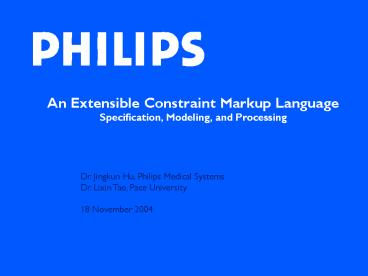An Extensible Constraint Markup Language Specification, Modeling, and Processing PowerPoint PPT Presentation
1 / 34
Title: An Extensible Constraint Markup Language Specification, Modeling, and Processing
1
An Extensible Constraint Markup
LanguageSpecification, Modeling, and Processing
Dr. Jingkun Hu, Philips Medical Systems Dr. Lixin
Tao, Pace University 18 November 2004
2
Outline
- XML constraints
- Problem statement
- Previous work
- eXtensible Constraint Markup Language (XCML)
- Visual modeling of XML constraints
- XCML constraint processing
- Conclusions and future work
3
What are XML constraints
- Syntactic constraints and semantic constraints
- Syntactic constraints those restrictions on the
structures, data types, and data formats. - Semantic constraints those restrictions on the
content of XML documents. - A semantic constraint can be expressed in the
form of an assertion (true/false statement) or a
rule (if-then-else) with embedded assertions. The
content of a constraint can be static or dynamic.
4
Semantic XML Constraints
5
Sample XML constraints- Assertion-based
- The value of element taxRate must be 0.06.
- The value of element taxRate must be greater than
0.02 and less than 0.10. - The value constraint of element taxRate varies
from state to state. - The amount of tax must equal to the product of
net income and tax rate. - (Schema diagram of sample XML document)
6
Sample XML constraints - Rule-based
- If the value of an employees role does not equal
to manager, then department element must not be
present. Otherwise, it must be present at least
once. - If the value of netIncome is less than or equal
to a given value of parameter level, then the
value of taxRate should be 0.05 .
7
Problem statement
- Validating XML documents against Schemas
(syntactic validation) is not sufficient in
practice. - Syntactic validity cant guarantee if XML
documents meaningful. - Semantic validation is necessary.
- How to express semantic constraints.
8
Problem statement (Contd)
- Manually creating XML constraint documents is a
painful task. - Can XML constraints be visually modeled so that
constraint documents are automatically generated?
9
Previous work
- W3C XML Schemas (WXS)
- Schematron, Jelliffe
- XML Constraint Specification Language (XCSL),
Ramalho - eXtensible Inter-Nodes Constraint Markup Language
(XincaML), IBM - Xlinkit, Nentwich
10
eXtensible Constraint Markup Language (XCML)-
Specification
11
Syntax
12
Sample XCML definitions
ltConstraint contextpayrollgt ltAssertion
testtaxRate0.06/gt lt/Constraintgt
ltConstraint contextpayrollgt ltAssertion
testtaxRate gt 0.02
and taxRate lt 0.10/gt lt/Constraintgt
ltConstraint contextpayrollgt ltAssertion
testtax netIncome taxRate/gt lt/Constraintgt
13
Sample XCML definitions (Contd)
ltConstraint contextpayrollgt ltParametergt
ltnamegtratelt/namegt
lttypegtfloatlt/typegt ltdefaultValuegt0.07lt/de
faultValuegt lt/Parametergt ltAssertion
testtaxRaterate/gt lt/Constraintgt
14
Sample XCML definitions (Contd)
ltConstraint context"employee"gt ltRulegt ltIf
testyearsOfWork gt 5/gt ltThen
testpayroll/hasSavingFund true/gt ltElse
testpayroll/hasSavingFund false/gt lt/Rulegt
lt/Constraintgt
15
Comparison of XCML with existing XML constraint
languages
16
XCML constraints - Visual modeling
17
XML data modeling
- UML and XML Schemas
- Carson, Provost, and Routledge et al.
- Three-level-design approach without constraints
- Conceptual, logical, and physical
- Three-level-design approach with constraints
- Conceptual, logical, and physical
18
Three-level-design approach
(a)
(b)
19
UML profile for XCML schema
20
Sample physical models
- XML Schema document
- XCML instance document
21
XML schema document of employee profile
- ltxsschema xmlnsxs"http//www.w3.org/2001/XMLSch
ema"gt - ltxselement name"employee" typeEmployee"/gt
- ltxscomplexType nameEmployee"gt
- ltxssequencegt
-
- ltxselement name"role" typeRoleType"/gt
- ltxselement name"department"
typeDepartmentType" minOccurs"0"/gt - ltxselement name"yearsOfWork"
type"xsinteger"/gt - ltxselement name"payroll" typePayrollType"/gt
- lt/xssequencegt
- ltxsattribute name"employeeID"
type"xsstring" use"required"/gt - lt/xscomplexTypegt
- ltxscomplexType namePayrollType"gt
- ltxssequencegt
- ltxselement name"salary" type"xsfloat"/gt
- ltxselement name"bonus" type"xsfloat"/gt
- ltxselement name"taxRate" type"xsfloat"/gt
- ltxselement name"tax" type"xsfloat"/gt
22
XCML instance document for employee profile
ltxcmlConstraints name"Employee Profile
Constraints" xmlnsxcml"http//www.csis.pace.edu
/dps/xcml" xmlnsxsi"http//www.w3.org/2001/XMLS
chema-instance" xsischemaLocation"http//www.csi
s.pace.edu/dps/xcml ..\..\schema\xcml\Constraints.
xsd"gt ltConstraint context"employee"gt ltRulegt
ltIf testyearsOfWork gt 5/gt ltThen
test"payroll/hasSavingFund 'true'"/gt ltElse
test"payroll/hasSavingFund 'false'"/gt lt/Rulegt
lt/Constraintgt ltConstraint context"employee/pay
roll"gt ltAssertion test"salary bonus - tax
netIncome"/gt lt/Constraintgt ltConstraint
context"employee"gt ltRulegt ltIf test"role
manage/gt ltThen test"count(department) gt
1"/gt ltElse test"count(department)
0"/gt lt/Rulegt lt/Constraintgt lt/xcmlConstraintsgt
23
XCML constraints - Processing
24
Design and implementation
- Generation of XML Schemas and XCML instance
documents - XML document validation
- Technologies UML 1.4, XMI 1.1, and XSLT 1.0
25
Workflow of generating XML Schemas and XCML
instance documents
26
Workflow of XML document validation
27
Conclusions
- Proposed XCML is much more powerful than the
existing XML constraint languages in expressing
various constraints specifically dynamic and
composite rule-based ones. - Using OCL and the proposed UML profile for XCML
schema together with a UML profile for W3C XML
Schema can model XML constraints over XML data
models.
28
Conclusions (Contd)
- UML modeling of XCML makes the design of XCML
instance documents model-driven. - The automation of XCML instance documents
generation can be done using XMI and XSLT
technologies.
29
Future work
- OCL 2.0 vs XML Constraint Languages
- Xlink use in XCML
- Reference implementation
30
Sample Schema document
31
Conceptual mode of Employee profile(w/o
constraints)
32
Logical model of Employee profile(w/o
constraints)
33
Sample conceptual model
34
Sample logical model

